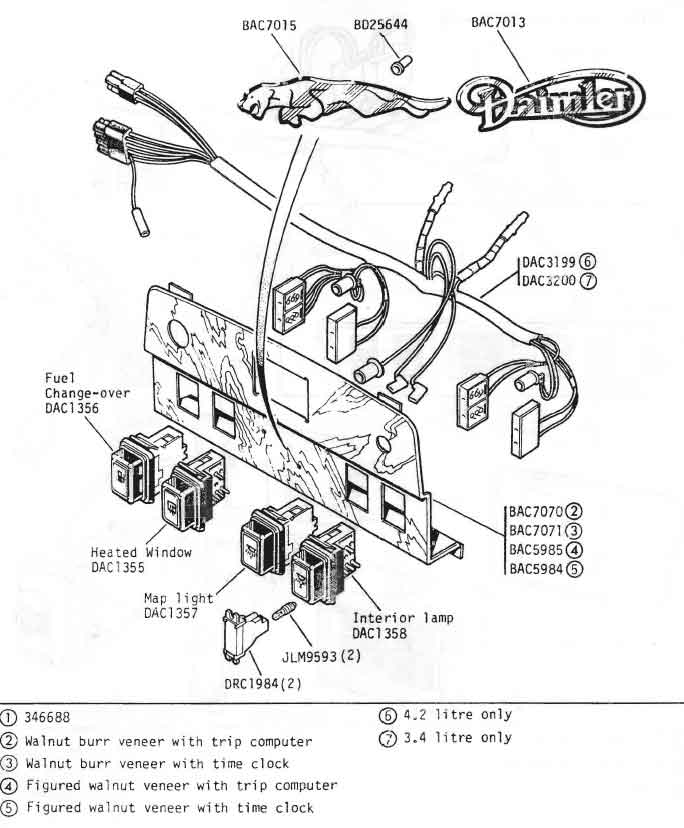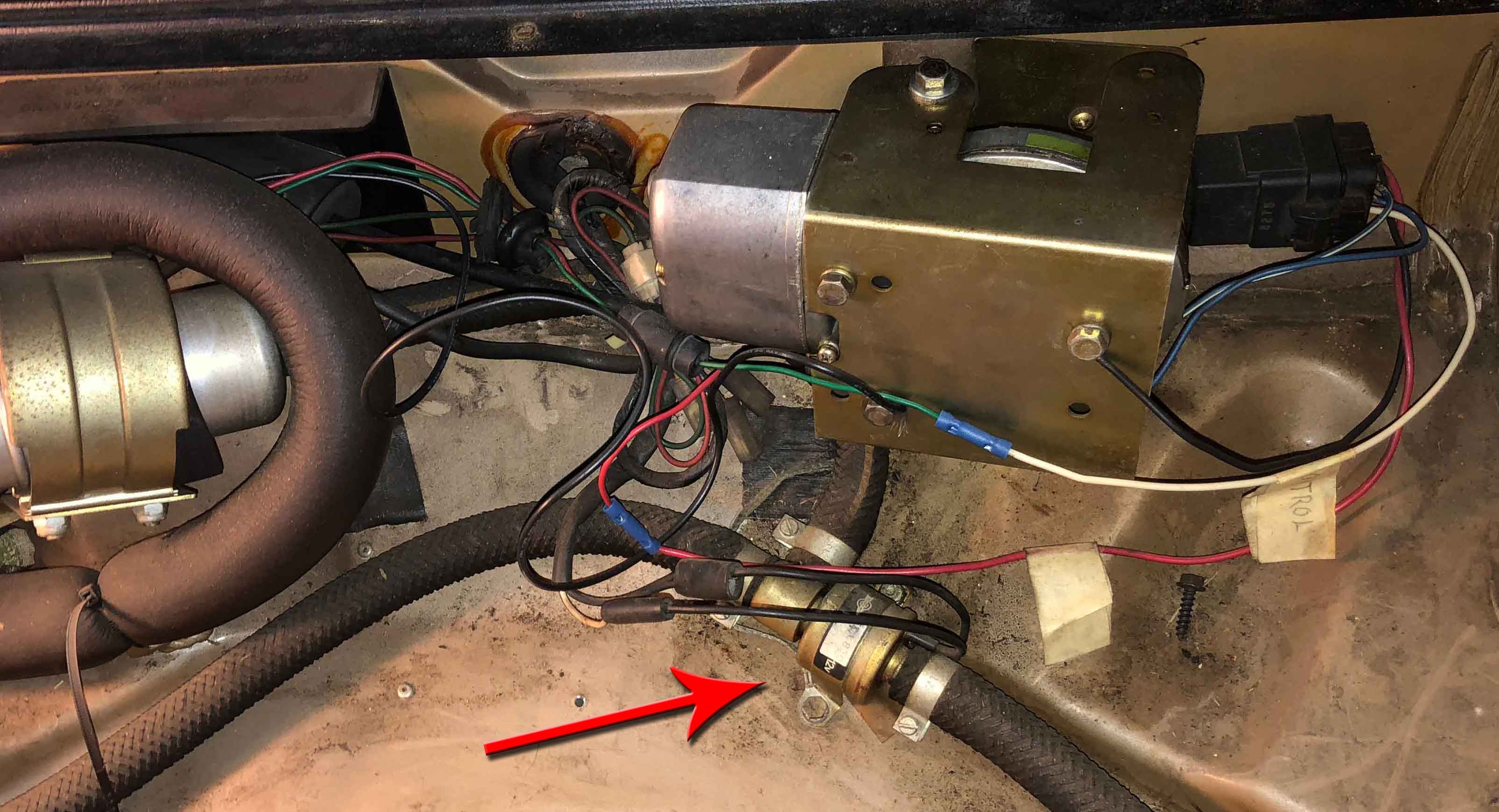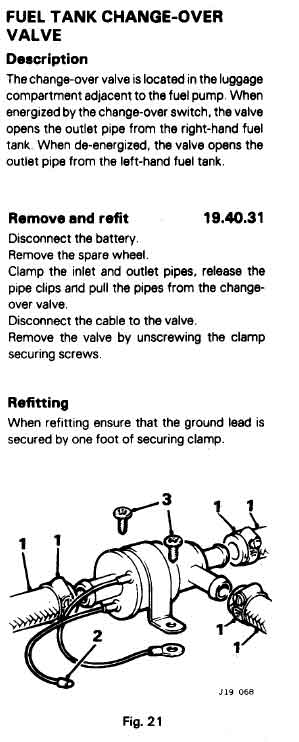The Fuel Changeover Switch
As I type this we're still in the stay-at-home phase of the coronavirus pandemic (Spring of 2020). I'm bored, so I'm going to write out the long version. (That and I feel like somtimes a lot of detailed context helps explain what's going on.)
Background
Jaguar Series I, II and III XJ6s, the XJ6C, the XJS coupes, the Mark X and I believe the old S-types, have separate, twin gas tanks—one inside each fender right behind the rear tires. I'm told this improves handling since the gas doesn't roll horizontally across the car every time you turn a corner.
The tanks are selected manually by the driver using a two-position push switch in the cabin of the car. It's located on the far left of a bank of four switches, in the center panel just above the radio and the climate controls.
These are the same regardless of whether you have a left-hand-drive or right-hand-drive car, which simplifies things a bit. But to make up for it, Jaguar mounted these into two different styles of center panel. One style had an analog clock set in the middle of the bank of four swtiches. Above this bank was a curved parcel tray. The other version omitted the clock and the curved shelf, and added an upper panel which had the LED-readout trip computer, a dial to dim the dash lights, and a cigar lighter. They also added a leaping cat or Daimler logo.

The car has two fuel tanks but it shares one fuel pump, located in the trunk, and one fuel filter, also located in the trunk (at least mine. Earlier cars may have things located up under the hood). There is one fuel gauge on the dashboard, but there are separate fuel-level-sending units, one in each tank. When you push the button, two things happen: one is that the fuel gets drawn from whichever tank is selected, and the gauge gets the electrical signal from the sender in that tank.
The Problem
One of the chronic problems I've had with the car is that the fuel sender in the driver's side tank is unreliable. The sender is a long, spindly, spring-loaded metal arm with a plastic bob on the end that floats on the surface. The arm is attached to a panel that fits into the back side of the tank (you have to remove the tail lamp assembly to see it), and the position of the arm tells the gas gauge how much fuel there is. The bob on mine had a pinhole, so it filled with gas and sank. We fixed it, but ever since it's only worked whenever it felt like it. The passenger side sender always behaved.
A couple years ago the driver's side sender quit outright. It's been low priority for me because fixing it requires siphoning the tank, and after that extracting the sender is itself a pain in the ass. Considering the laundry list of things that had to be done getting the car through smog, it kept being put off. And then when the car was running, I wanted to let my bank account heal and enjoy driving rather than fussing with more problems.
That was a mistake.
What I noticed more recently was that both senders had quit. I now couldn't get a fuel level on either tank. This meant either the gauge was bad, which would require me to pull the dash and replace it, which I want to do like I want to have all my teeth pulled, or I'd have to fix both senders. I procrastinated.
It was easy to work around—I only drive the car on weekends so I don't have to gas up very often, so I just tried to keep it topped off. But one day recently the car started acting as if it were out of gas. I switched tanks. No change. Hell—I'm out of gas on both sides. I didn't think I'd driven that far. Regardless, I limped into a gas station to fill up.
The left tank drank like a camel, but the right tank was already full.
That meant there was a problem with the changeover somewhere. I was only drawing from the left tank. That would explain why I was surprised by being out of gas.
Where is the Problem
I read Doug Dwyer's Fuel Tank Switchover Checklist over at XJ Lovers. The way the system works is that there are three valves that control the fuel flow, and they're located in the rear of the car. There's one at each tank, and a third that's a T-valve. All three are electrically switched and use 12V DC system power. When the switch on the center panel is in Left-side position (in), there is no 12V signal to any of the valves. The left-side valve is open, the T-switch routes the left-side fuel to the fuel pump, and the right-side valve is shut. If you push the switch to Right-Side (out), you get 12V at all the valves. This shuts the left-side tank, opens the right side tank, and swiches the T-in the middle to take the fuel from the right side.

The problem could be, in order of ascending difficulty:
Bad switch on the center console. Either you're always sending zero volts or 12V regardless of the switch's position.
Bad valves, either electrically not following the signal or mechanically stuck and can't follow the signal.
-
A wire break somewhere between the switch in the cabin and the valves in the trunk (open circuit).
 To diagnose this you start by seeing if you have 12V on the valves. The easiest valve to get to is the T-valve, which is against the back panel of the spare-wheel well, in-between the original antenna motor and the fuel pump (see photo above). I unloaded the trunk, removed the full-size spare tire (that tells you something about how old this car is), and found the T-valve.
To diagnose this you start by seeing if you have 12V on the valves. The easiest valve to get to is the T-valve, which is against the back panel of the spare-wheel well, in-between the original antenna motor and the fuel pump (see photo above). I unloaded the trunk, removed the full-size spare tire (that tells you something about how old this car is), and found the T-valve.
According to Mr. Dwyer, you put the ignition key to ON so you get power, and check for 12V at the T-valve's electrical connections. If the fuel switch is in Left position you should get 0V. If it's in Right you should get 12V.
Dwyer uses a 12V test lamp but I used a digital multimeter on the 20V scale. I got zero regardless of switch position.
The problem with this situation is there are so many reasons for getting 0V that have nothing to do with faults and everything to do with incompetence on my part. I happened to have a 12V DC power supply, so I brought it over and applied 12V DC directly to the valve.
CLICK and a hum. Did it a couple more times and got the same result.
That means either a bad switch in the cabin or bad wiring somewhere. Bad switch is far more likely. It's 36 years old now. I may be able to open up the switch and clean it. But most likely I need to replace it.
(I later read a comment from Gregory Andrachuk, whose credibility is such that I would trust him if told me to fill the gas tanks with lime Jello, saying that unlike the window switches the fuel change-over switch is complicated and not a good candidate for repair. Better to replace it.)
I put a gallon of gas in the left tank so I could get to the corner station and fill it. While I was warming up the car, I started pushing the fuel switch rapidly in and out, hoping to clean the contacts inside. Didn't work, but I did notice that the fuel gauge needle would wiggle. Eventually I found that if I held the button down when selecting the right side tank, the needle would respond and give me a level. I also heard the valve switch click in the back. Couldn't make it select and stay. But at least that's confirmation that the switch really is the problem, not some electrical gremlin elsewhere.
The Replacement Switch
So this is where I am now. The switch is going to have to come out no matter what. That requires removing the panel.
Like many others, I'm sure, and certainly from every other XJ6 I've personally seen, the varnish or whatever they used as clear-coat on the wood veneer is cracked and chipping away. I've also lost a piece of veneer itself. If I have to pull the center panel, this would be a fine time to replace the veneer and do it all at one fell swoop.
But that, my friends, is expensive. Especially if I want one matched to the big dash panel.
The other option is just to buy a switch or go to the junk yard and pull one, which I will do anyway because it lets me practice removing the center panel on someone else's car.
By the way, it pays to shop around. I'm not going to name the competitors because I may need something some day and don't want to piss anyone off, but one prominent source had the switch for $100, another for $69.50, and an internet-only outfit I'd never heard of for $32 with free shipping, which is the best deal overall but makes me wonder if it's a ripoff. Ultimately I ordered one from Terry's Jaguar, a reputable company, at $27.60. To make the shipping worthwhile I added the left-hand fuel sender, which was also nicely priced.
As mentioned above, I went to the friendly local pull-it-yourself yard (this one really is friendly) and pulled the center panel. I didn't photograph removal because EverydayXJ and Jeff's video do a better job. But I was surprised at how easy it turned out to be. I ended up getting the whole thing, trip computer, switches, even the leaping cat, because there may come a time later when I'll need one of those.
The fuel sender replacement has its own page.
The switch turned out to be relatively easy to replace. The center console came out fairly easily. The new switch went in, then the console buttoned back up. Worked like charm.
